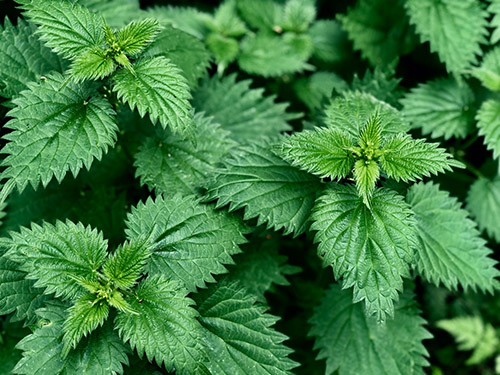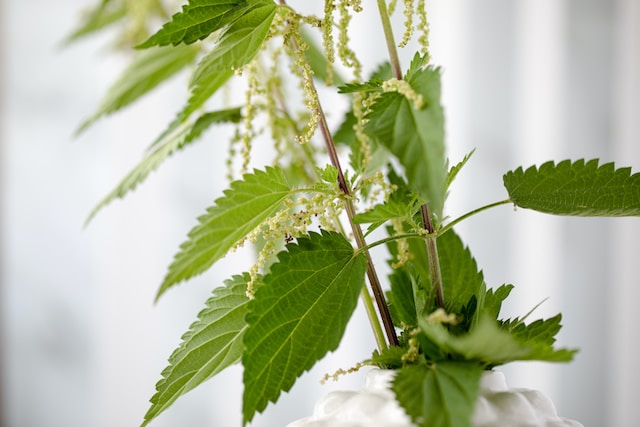Most people at some point will have experienced the pain of a nettle sting. I once managed to fall hands-first from a fence into a whole patch of nettles. So it’s hardly surprising that people consider them unwanted or unloved plants.
The stinging nettle, or common nettle (Urtica dioica) is Europe’s most common nettle. Other names for the plant include burning weed, fire weed, and burning nettle (Dietz 2020: 223).

But as we’ve seen with other unwanted plants like daffodils and celandine, it has a part to play! Caterpillars feed on the leaves, including those of small tortoiseshell, comma, peacock, and red admiral butterflies. Aphids eat the leaves, which then attract ladybirds to eat the aphids. Other animals depend on it, including chaffinches, bullfinches, sparrows, frogs, toads, shrews, and hedgehogs (Cottam 2019).
And there’s more! It’s (surprisingly) edible, and has a wealth of medicinal and magical lore in its spiky back pocket. Let’s discover how you can use nettles to ward off witchcraft, boost your iron intake, and even dye fabric!
But nettles hurt!
The main reason people hate nettles is their sting, which comes from the tiny hairs on their leaves. When these hairs get stuck in the skin, they inject histamine, which causes inflammation. According to Ruth Binney, people thought the hairs were “the prongs of the Devil’s pitchfork” in Ireland (2018: 113).
Many people believe that rubbing dock leaves on a nettle sting will help. The remedy appears in Old English texts. Chaucer repeats an old charm in Troilus and Creseyde in 1386, ‘Netle in, dokke out’, that you would recite while using the dock leaf.

Contrary to what a lot of people think, rubbing dock leaves won’t necessarily soothe the stings. The sap released by the leaves does nothing to counteract the chemicals of the sting. That said, researchers think using a dock leaf still helps because of a combination of the rubbing action and the good old-fashioned placebo effect (Morton 2021).
I can’t help thinking you’re better off carrying an antihistamine ointment if you’re in nettle country. In the UK, I use Anthisan, which is also good for insect bits and stings as well, but always check with your GP which one is right for you first.
Dock leaves themselves are unwanted plants, and were covered by the 1959 Weeds Act, which meant landowners had to stop their spread of pay a £1000 fine (Morton 2021). But we’re not here for them. We’re here for the nettles.
Useful Stingers?
According to Margaret Baker, people used nettle oil before paraffin was invented. The juice had a range of uses, including curdling milk to create Cheshire cheese, sealing a leaking barrel, and keeping flies away from a larder (2011 [1969]: 106).
She also notes that people added dried nettles to mash to help chickens with egg production. Nettle compost would boost ailing plants while packing tomatoes and stone fruit in nettle leaves kept them fresh for longer (2011 [1969]: 106).
You can boil the leaves to create a green dye that stays vibrant on natural fibres (Inkwright 2020: 115). Or shred the stalks to make paper, or turn them into fibres so you can weave fabric or spin yarn (Inkwright 2020: 115).

The plant is a good source of magnesium, iron, calcium, and vitamins A, B, C, and D (Inkwright 2020: 115). People drink nettle tea, while others eat the leaves and shoot tips, often in soups (Inkwright 2020: 115). Nettle pudding is believed to be Britain’s oldest pudding, dating to 6000 BC. People once made both beer and wine from the plant, while nettle soup is a popular way to eat them (Great British Chefs 2023).
The Great British Chefs website recommends handling fresh nettles with gloves, and always washing them before you use them. Blanch them in boiling water to neutralise the sting, and then treat them as you would cooked spinach leaves (2023).
Nettle Remedies
Nettles also appear in a range of old remedies, though as always, don’t try these at home. Be careful before you start eating or using nettles – pregnant women shouldn’t use it at all. Don’t use herbal preparations unless you’ve spoken to your GP as herbs can sometimes interact with medication.
The ancient Romans deliberately stung themselves with nettles in cold climates to stave off the cold (Binney 2018: 114). Clearly, any warmth they generated was due to the skin inflammation from the sting, not actual body heat. But according to Baker, the Romans recommended nettles to help ease rheumatic joints (2011 [1969]: 106).
This might sound counterintuitive since rheumatism causes inflammation. Surely you wouldn’t want to add more inflammation? Well, it seems that where nettles touch painful areas, they interfere with pain signals and actually reduce pain (Mount Sinai 2023).
In the medieval era, people believed that you could improve the growth of your hair with nettles. Squeeze juice from nettle leaves and dip your comb’s teeth in the juice every morning. Next, comb your hair the wrong way. Apparently, this would speed up the growth of the hair (Binney 2018: 114).

Medieval Europeans also used nettles as a diuretic, and here in the 21st century, nettles are used for a range of symptoms related to urinary problems (Mount Sinai 2023).
The 10th-century Lacnunga contains an invocation called the Nine Herbs Prayer (or Charm). S.E.S. Eberly theorises that reciting the charm may have helped practitioners ‘time’ their preparations (2011).
Alongside nettle, the recipe included mugwort, plantain, shepherd’s purse, betony, chamomile, crab apple, chervil, and fennel. The plants were boiled, mixed with soap, and made into a salve to treat skin infections. Julian Walker points to a recipe in Bald’s Leechbook for an ointment to treat muscular pain that contained nettles (2013).
Finally, in the 16th century, John Gerard recommended baking nettles with sugar in his Herball. The resulting confection would boost the “vital spirits” (Binney 2018: 114). To be fair, that would also probably taste quite nice.
More contemporary remedies
Baker notes that Guernsey fishermen swore by a liniment of nettles, oil and salt when rubbed onto the spine, wrists, and soles of the feet. Meanwhile, nettle tea was a recommended tonic:
If they’d eat nettles in March,
(Baker 2011 [1969]: 106)
And mugwort in May,
So many fine maidens
Wouldn’t go to the clay.
To ward off ague, Catherine Oswald prescribed the picking of nettle by its root before sunrise on three successive mornings (Folkard 1884: 460). Margaret Baker gives an alternative version: if a healer pulled up a nettle by its roots and spoke both the patient’s name and that of their parents, they could cure fever (2011 [1969]: 106).
That said, Scottish records from 1884 insisted that no one must speak to the nettle gatherer, and it had to be collected at midnight, to retain its medicinal virtues (Inkwright 2020: 115).
A respondent on Plant-lore.com noted that they dried nettles to turn into a tea infusion to help with cat allergies. A lot of people said they’d heard nettle stings helped ease arthritis and rheumatism, although a few suggested they added nettles to their bath for the condition. Other people said that steeping nettles in boiling water, straining the mixtures, and then pouring over freshly-washed hair made an excellent hair conditioner (Vickery 2021).

Sarah at Rowan & Sage has an entire monograph on nettles as part of her Herbaria membership, so if you’d like to learn more about using nettles, I highly recommend Herbaria (and Sarah’s materials in general). Click here to become a member!
Magical Nettles
Cornelius Agrippa believed Mars ruled the nettle since it worked “by touching the skin, burn it, prick it, or make it swell” (2003).
You could carry nettle and milfoil to drive off both fear and evil spirits (Folkard 1884: 460). You could also carry nettles in a pouch to break curses and return them to the sender (Dietz 2020: 223). The pouch seems like a good idea, so you don’t sting yourself.
In the Tyrol, people tried to ward off thunderstorms by casting nettles into the fire, since Thor ruled nettles. Gathering nettles before dawn could keep evil spirits away from their cattle (Baker 2011 [1969]: 106).

Fez Inkwright recommends drying nettle stalks to use as incense or ground into powder to use in spells. In Wales, people might place a handful of nettles under a sick person’s pillow. The next day, green leaves indicated a recovery, while brown leaves meant the patient would die (2020: 116).
Dreaming of being stung by nettles meant you would be vexed and disappointed. If you dreamt of gathering nettles it meant someone thought well of you. If you were married and had such dreams, then it meant you’d have harmony among your family (Folkard 1884: 460).
In the Victorian language of flowers, nettles meant slander (Burke 1858: 42). It’s unclear if that’s slander about you or by you, but the recipient would hopefully have the context to understand it.
Despite all the benefits listed here, other people called the nettle ‘Devil’s Apron’ because they believed Satan protected himself with the plant (Baker 2011 [1969]: 107).
So what do we make of the folklore of nettles?
Nettles are much like dandelions – incredibly useful, despite being so unwanted. Of course, dandelions don’t sting you. Still, boiling or blanching the leaves removes the sting, and then you can enjoy the benefits of them.
But it’s interesting to see them used both to ward off evil or return curses and considered as a plant of the Devil. It just goes to show that a baneful plant is also sometimes helpful against baneful influences, much like people using witchy charms to ward off witches.
It’s also a good reminder that the most useful plants often aren’t the prettiest, showiest, or most difficult to grow. Nettles are abundant, they offer a whole range of benefits, and they’re an important part of any garden ecosystem. Unlike a lot of the poisonous plants on this blog, yes, they’ll hurt, but they’re not toxic like monkshood or deadly nightshade.
So if you have any in your garden and you don’t have little ones to worry about, consider cultivating your little nettle patch. Maybe you’ll develop a taste for nettle soup!
What do you make of nettles?
References
Agrippa, Cornelius (2003), ‘What things are Martial or under the power of Mars’, Renaissance Astrology, https://www.renaissanceastrology.com/agrippamars.html.
Baker, Margaret (2011 [1969]), Discovering the Folklore of Plants, 3rd edition, Oxford: Shire Classics (aff link).
Binney, Ruth (2018), Plant Lore and Legend, Hassocks: Rydon (aff link).
Burke, L (1858), The illustrated language of flowers, London: G. Routledge & Sons.
Cottam, Laura (2019), ‘Why do nettles sting and do dock leaves really help?’, Woodland Trust, https://www.woodlandtrust.org.uk/blog/2019/05/why-do-nettles-sting/.
Dietz, S. Theresa (2020), The Complete Language of Flowers: A Definitive and Illustrated History, New York: Wellfleet Press (aff link).
Eberly, S.E.S. (2011), ‘The Nine Herbs Prayer
from the Lacnunga’, Wyrtig, http://www.wyrtig.com/GardenFolklore/NineHerbsPrayer.htm.
Folkard, Richard (1884), Plant lore, legends, and lyrics : Embracing the myths, traditions, superstitions, and folk-lore of the plant kingdom, London : S. Low, Marston, Searle, and Rivington.
Great British Chefs (2023), ‘How to cook nettles’, Great British Chefs, https://www.greatbritishchefs.com/how-to-cook/how-to-cook-with-nettles.
Inkwright, Fez (2020), Folk Magic and Healing: An Unusual History of Everyday Plants, London: Liminal 11 Press (aff link).
Morton, Ian (2021), ‘Curious Questions: Do dock leaves really cure stinging nettle stings?’, Country Life, https://www.countrylife.co.uk/nature/curious-questions-do-dock-leaves-actually-soothe-stinging-nettle-stings-231517.
Mount Sinai (2023), ‘Stinging nettle’, Mount Sinai, https://www.mountsinai.org/health-library/herb/stinging-nettle.
Vickery, Roy (2021), ‘Nettle’, Plant-Lore.com, https://www.plant-lore.com/nettle/
Walker, Julian (2013), ‘Anglo-Saxon Medicine’, British Library, https://britishlibrary.typepad.co.uk/digitisedmanuscripts/2013/10/anglo-saxon-medicine.html.
Nutty about folklore and want more?
Add your email below and get these posts in your inbox every week.
You'll also get my 5-step guide to protecting your home using folklore!








I can’t imagine unsubscribing over a post on plants you didn’t like ! Although if you posted more than once about zucchini…
its weird years ago there was loads of nettles about but i dont think i have seen any for years i just relised then whil listening to you they used to be all over but doesnt seem to be as miuch now also its said were nettles are it supposed to be dock leaves near by the nettles its so you can rub them on the sting i got stung so much as a kid and used the dock leavs it helped a bit but it could have been a placebo effct we thinkm its working and it is our brain saying yea course it is you daft sod but i have not seen them in years is it just me or what i live sml seaside town but have woods and so on places where it would grow but not seen sadly THANKS AGAIN for another great pod cast love these so much look forward to every sunday i get it on a sat but save it till sunday so i get to listen to in in morning when house is quite and no bother i sist and enjoy the pod cast you do nothing better on a sunday morning its the only thing i look forward to on a sunday so THANK YOU